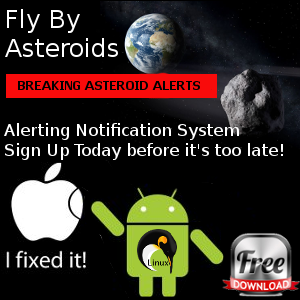Asteroid 2002 AJ129 to Fly Safely Past Earth February 4
Asteroid 2002 AJ129 will make a close approach to Earth on Feb. 4, 2018, at 1:30 p.m. PST (4:30 p.m. EST). At the time of closest approach, the asteroid will be at a distance of 2.6 million miles, or 4.2 million kilometers — about 10 times the distance between Earth and the moon.
Asteroid 2002 AJ129 will make a close approach to Earth on Feb. 4, 2018 at 1:30 p.m. PST (4:30 p.m. EST / 21:30 UTC). At the time of closest approach, the asteroid will be no closer than 10 times the distance between Earth and the Moon (about 2.6 million miles, or 4.2 million kilometers).
2002 AJ129 is an intermediate-sized near-Earth asteroid, somewhere between 0.3 miles (0.5 kilometers) and 0.75 miles (1.2 kilometers) across. It was discovered on Jan. 15, 2002, by the former NASA-sponsored Near Earth Asteroid Tracking project at the Maui Space Surveillance Site on Haleakala, Hawaii. The asteroid’s velocity at the time of closest approach, 76,000 mph (34 kilometers per second), is higher than the majority of near-Earth objects during an Earth flyby. The high flyby velocity is a result of the asteroid’s orbit, which approaches very close to the Sun — 11 million miles (18 million kilometers). Although asteroid 2002 AJ129 is categorized as a Potentially Hazardous Asteroid (PHA), it does not pose an actual threat of colliding with our planet for the foreseeable future.
“We have been tracking this asteroid for over 14 years and know its orbit very accurately,” said Paul Chodas, manager of NASA’s Center for Near-Earth Object Studies at the Jet Propulsion Laboratory, Pasadena, California. “Our calculations indicate that asteroid 2002 AJ129 has no chance — zero — of colliding with Earth on Feb. 4 or any time over the next 100 years.”
JPL hosts the Center for Near-Earth Object Studies for NASA’s Near-Earth Object Observations Program, an element of the Planetary Defense Coordination Office within the agency’s Science Mission Directorate.
More information about asteroids and near-Earth objects can be found at:
https://www.jpl.nasa.gov/asteroidwatch
For more information about NASA’s Planetary Defense Coordination Office, visit:
https://www.nasa.gov/planetarydefense
For asteroid and comet news and updates, follow AsteroidWatch on Twitter:
DC Agle
Jet Propulsion Laboratory, Pasadena, Calif.
818-393-9011
agle@jpl.nasa.gov
2018-011
